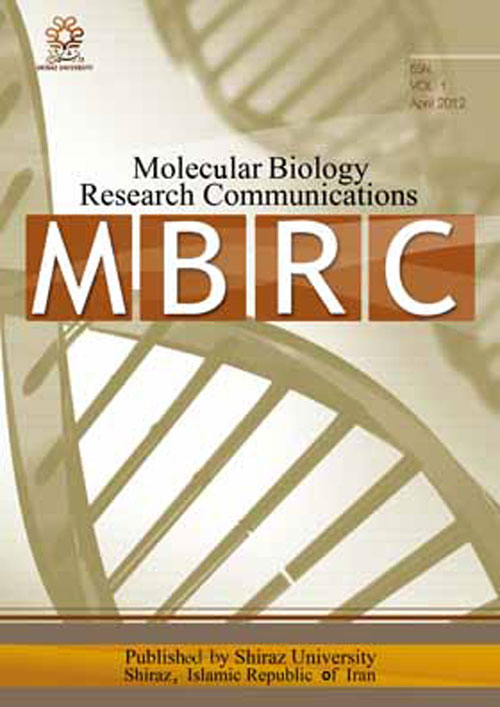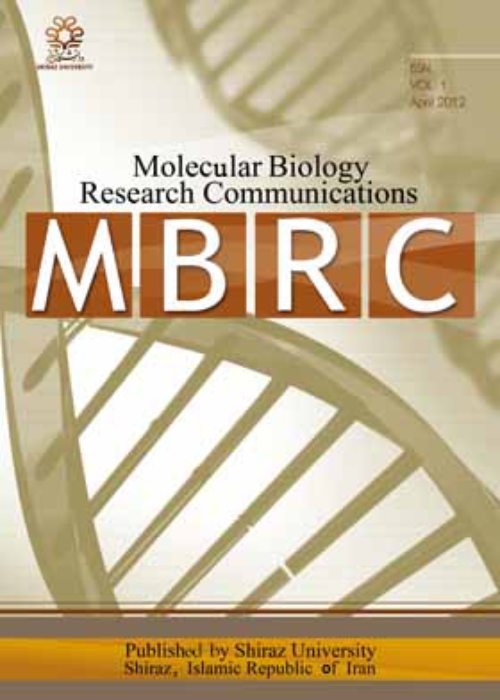فهرست مطالب

Molecular Biology Research Communications
Volume:5 Issue: 2, Jun 2016
- تاریخ انتشار: 1395/04/11
- تعداد عناوین: 6
-
-
Pages 65-75Traditionally, Capoeta populations from the southern Caspian Sea basin have been considered as Capoeta capoeta gracilis. Study on the phylogenetic relationship of Capoeta species using mitochondrial cytochrome b gene sequences show that Capoeta population from the southern Caspian Sea basin is distinct species and receive well support (posterior probability of 100%). Based on the tree topologies obtained from Bayesian and Maximum Likelihood methods, three main groups for the studied Capoeta were detected: Clade I) Capoeta trutta group (the Mesopotamian Capoeta group) including closely related taxa (e.g. trutta, turani, barroisi) characterized by having numerous irregular black spots on the dorsal half of the body. This clade was the sister group to all other Capoeta species and its separation occurred very early in evolution possess, so we considered it as Old Evolutionary Group. Clade II) comprises highly diversified and widespread group, Capoeta damascina complex group (small scale capoeta group), the Anatolian-Iranian group (e.g. banarescui, buhsei, damascina, saadii), characterized by small scales and plain body (absence of irregular black spots on the dorsal half of the body, except in some juveniles) with significantly later speciation event so called Young Evolutionary Group. Clade III) Capoeta capoeta complex group (large scale capoeta group, the Aralo-Caspian group) comprises very closely related taxa characterized by large scales and plain body (absence of irregular black spots on the dorsal half of the body) distributed in Aralo-Caspian water bodies (capoeta, ekmekciae, heratensis, gracilis, sevangi) that has been recently diverged and could be considered as Very Young Evolutionary Group.Keywords: Phylogenetic relationship, Evolutionary History, Capoeta Gracilis, Caspian Sea basin
-
Pages 77-85In the past three decades, study on the biological effects of extremely low-frequency electromagnetic fields (ELF-EMFs) has been of interest to scientists. Although the exact mechanism of its effect is not fully understood, free radical processes has been proposed as a possible mechanism. This study was designed to evaluate the effect of 50-Hz EMFs on the mRNA levels of seven antioxidant genes (CAT, SOD1, SOD2, GSTO1, GSTM3, MSGT1, and MSGT3) in human MCF-7 cells. The EMF exposure patterns were: 1) 5 min field-on/5 min filed-off, 2) 15 min field-on/15 min field-off, 3) 30 min field-on continuously. In all three exposure conditions we tried to have total exposure time of 30 minutes. Control cultures were located in the exposure apparatus when the power was off. The experiments were done at two field intensities; 0.25 mT and 0.50 mT. The RNA extraction was done at two times; immediately post exposure and two hours post exposure. The mRNA levels were determined using quantitative real-time polymerase chain reaction. MTT assay for three exposure conditions in the two field intensities represented no cytotoxic effect on MCF-7 cells. Statistical comparison showed a significant difference between 0.25 mT and 0.50 mT intensities for "the 15 min field-on/15 min field-off condition" (Fisher's exact test, P=0.041), indicating that at 0.50 mT intensity field, the number of down-regulated and/or up-regulated genes increased compared with the other ones. However, there is no statistical significant difference between the field intensities for the two others EMF exposure conditions.Keywords: ELF, EMF, Antioxidant, Gene expression, MCF, 7
-
Pages 87-95Myricetin (Myc) is one of the most important flavonoids in diet due to its abundance in foods with the highest antioxidant activity. The antioxidant activity of Myc was studied in cell-free and cell-based systems to evaluate the ROS protection efficiency of Myc. The studies were based on the assessment of reducing power of Myc according to ferric ion reduction and intracellular ROS level measurement by assaying the cellular fluorescence intensity using dichlorodihydrofluorescein (DCF) probe as an indicator for ROS in cells. Moreover, the antitoxic capability of Myc was assessed using MTT method. Data indicated that intracellular ROS are highly toxic and applying low concentration of Myc not only inhibited cellular ROS production but also was accompanying with the protection of cells against the highly toxic and the lethal effects of peroxide compounds. Because of strong correlation between cellular ROS and their cell toxic properties, the higher antioxidant potency of Myc in cell medium resulted in effectively blocking intracellular ROS and protecting cell death. This property is achieved by the help of high polar solubility and cell membrane permeability of Myc.Keywords: Myricetin, ROS, Antioxidant, MTT, FRAP
-
Pages 97-100Catalase (CAT, OMIM: 115500) is an endogenous antioxidant enzyme and genetic variations in the regulatory regions of the CAT gene may alter the CAT enzyme activity and subsequently may alter the risk of oxidative stress related disease. In this study, potential influence(s) of the A-21T (rs7943316) and C-262T (rs1001179) genetic polymorphisms in the CAT promoter region, using the ALGGEN-PROMO.v8.3 online software were analyzed. Our findings show that the A allele at the -21 position creates a new potential binding site for PAX-6 and the T allele at the -262 position changes the TFII-I binding site into STAT4 response element. The PAX-6 and STAT4 are the multifunctional and enhancing transcription factors.Keywords: Catalase, PAX, 6, STAT4, Transcription factors
-
Pages 101-113Geminiviruses cause curly top disease, in dicotyledonous plants which constrains host crop production. Beet curly top Iran virus (BCTIV) is a widespread Becurtovirus (family Geminiviridae) in numerous areas within Iran. In this study, we isolated and analyzed a full-length genomic DNA of a new variant of BCTIV from pepper crops in the Kaftark region, east of Shiraz (proposed acronym: BCTIV-Kaf [IR: Kaf:2016:Pepper]). Infected pepper plants showed shortening of internodes, severe interveinal chlorosis, upward leaf rolling and leaf curling. Sequence and phylogenetic analysis showed this BCTIV variant grouped with sugar beet isolates of BCTIV and has the highest similarity to a sugar beet BCTIV isolate from Negar town in Kerman province, Iran. It was more distantly related to a bean isolate of BCTIV from northeast region of Iran. A tandem repeat partial dimmer of BCTIV was constructed and found to be infectious in pepper, tomato and Nicotiana benthamiana plants. Results of this study indicated that BCTIV-Kaf is a new variant of BCTIV infecting pepper plants in Shiraz and that geographic location rather than the type of host plant has more effect on genetic diversity of BCTIV in Iran.Keywords: Agroinoculation, BCTIV, Geminivirus, Pepper
-
Pages 114-121HIV-1 envelope (env) glycoprotein mediates an important role in entry of the virus into the susceptible target cells. As env glycoprotein of HIV-1 is highly variable in the different geographical regions, in the present study, different properties of this protein in Iran are compared with five nearby countries. The sequences of HIV-1 env glycoproteins of Iran, Afghanistan, Russia, Turkey, Pakistan and Saudi Arabia databases were collected from databases. Amino acid composition and physical and chemical properties of the proteins from these countries were studied using Protparam and COPid tools. Receiver-operating characteristic (ROC) curve analysis and Support Vector Machine (SVM) were used to evaluate association between the properties of HIV-1 env glycoprotein of Iran with five nearby countries. The results verify that amino acid composition and four physical and chemical properties (molecular weight, isoelectric point, Aliphatic Index, and grand average of hydropathicity) of HIV-1 env protein in Iran and Russia were not significantly different. In conclusion, the results indicate that in silico techniques provide valuable information for comparing HIV-1 envelop glycoprotein in different geographical locations.Keywords: Amino acid composition, Envelope glycoprotein, HIV, 1, Physical, chemical properties


